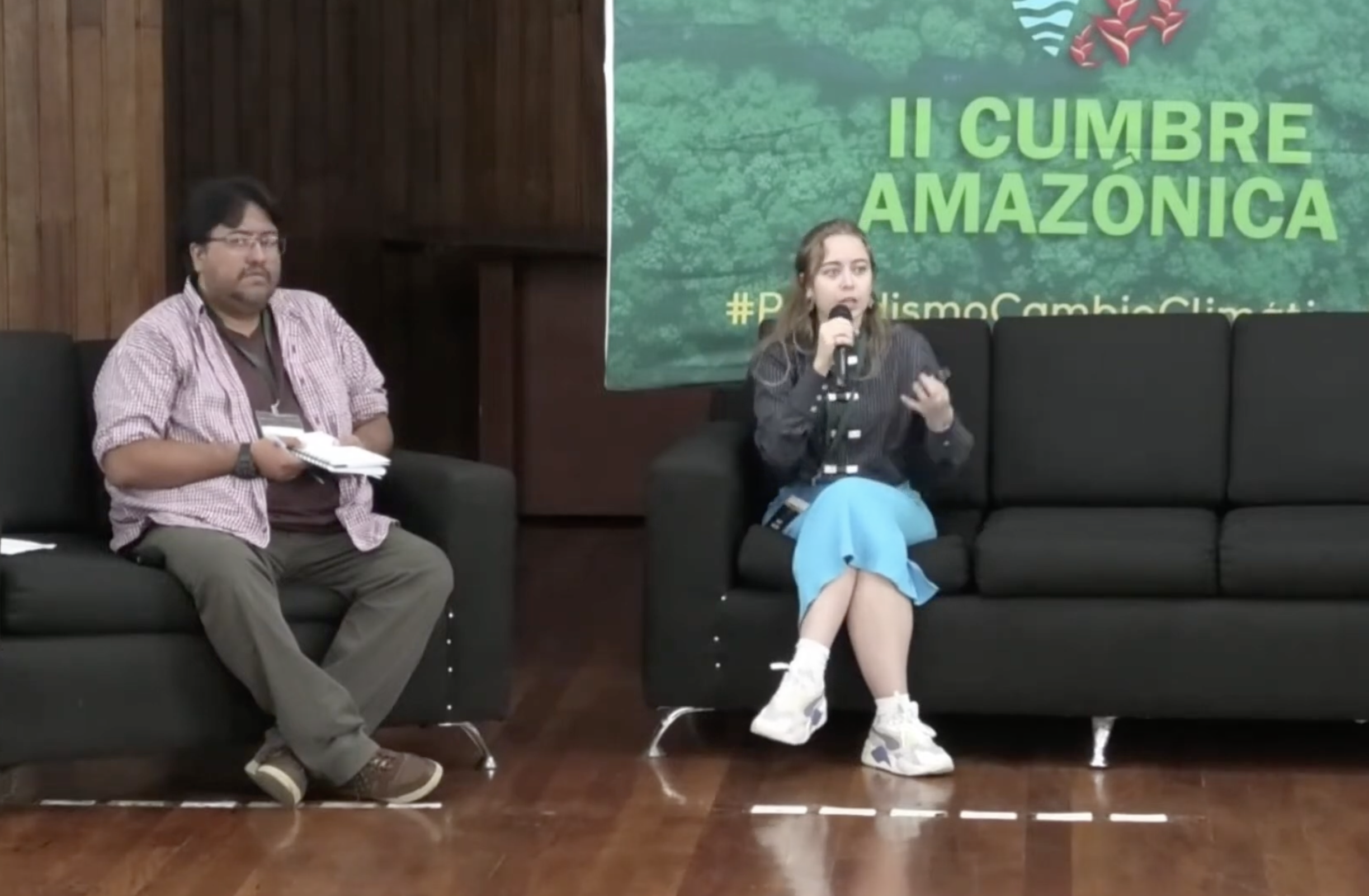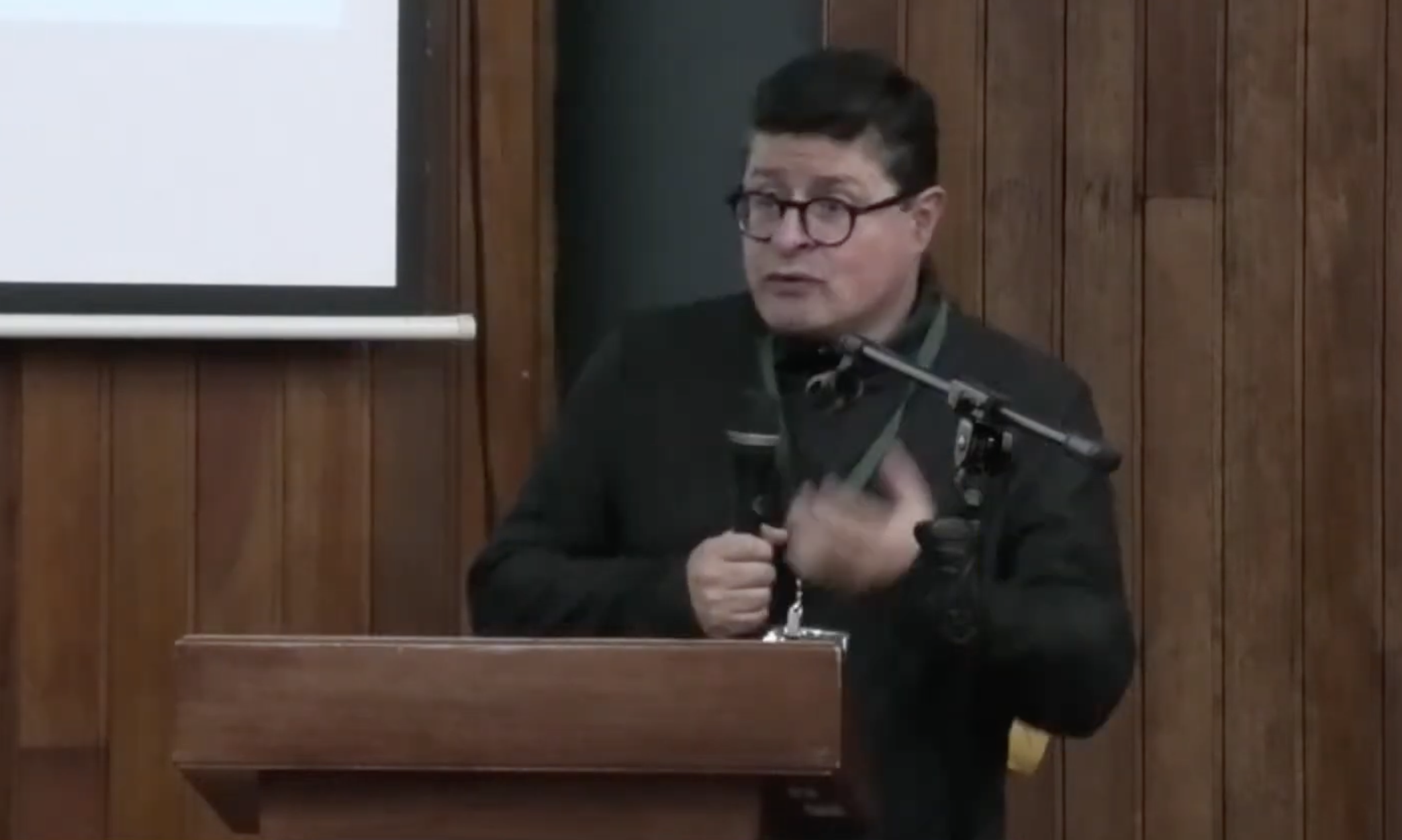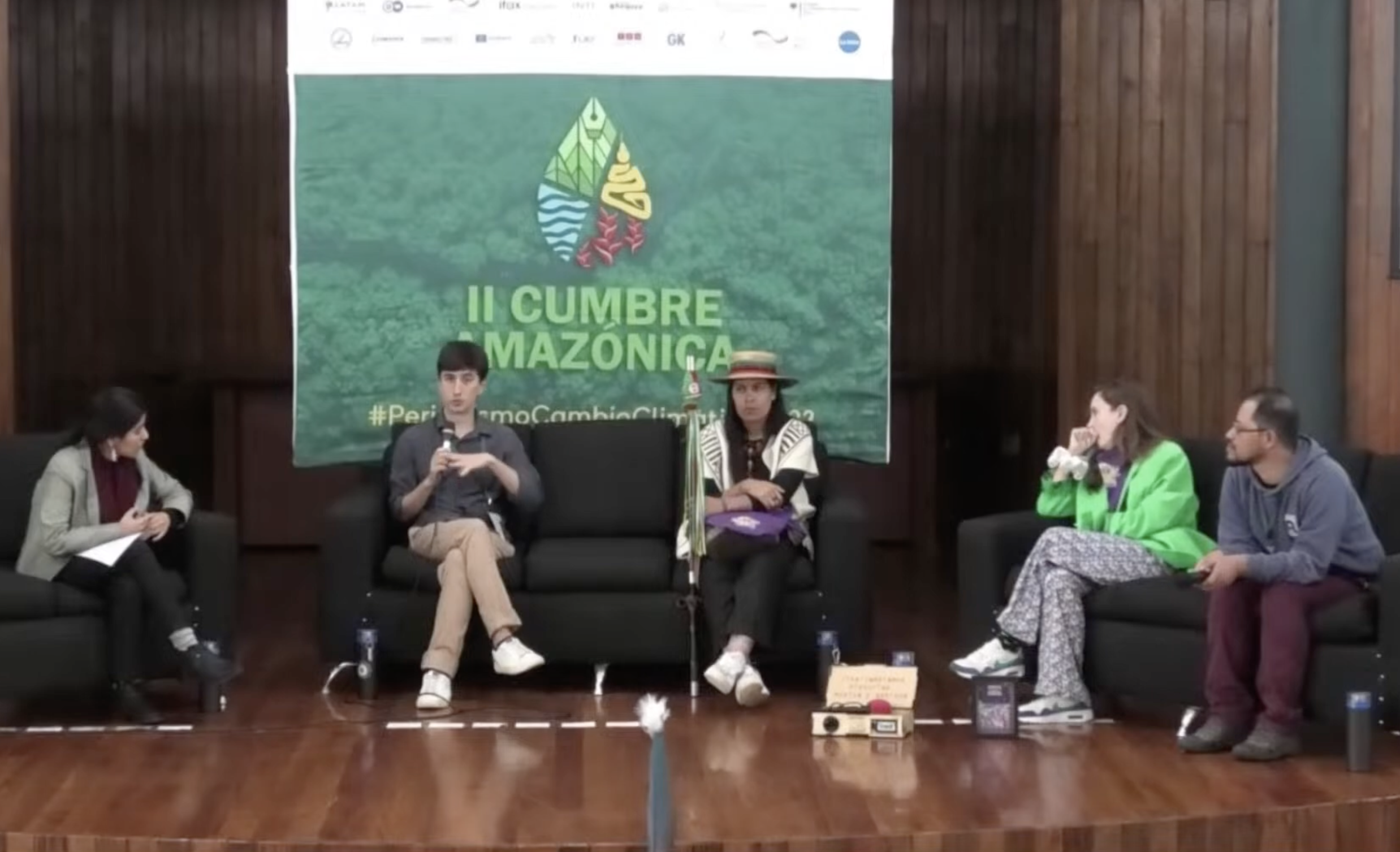The physical and digital security of journalists covering the Amazon, the latest climate change disinformation narratives and innovative digital security awareness techniques for Indigenous communities were some of the topics discussed at the II Amazon Summit on Journalism and Climate Change, which was held June 14-17 in Ecuador.
Organized by Fundamedios, an organization for the defense of journalism and freedom of expression, and the Amazon State University of Ecuador, the Summit was held for the second consecutive year on the campus of the university in the city of Puyo, in the Ecuadorian Amazon.
The event brought together journalists, academics, activists and representatives of Indigenous communities in lectures and panels. They also talked about various ways in which journalism and communication can help us understand the impact of climate change on the most vulnerable communities. In addition, they discussed how to strengthen journalists’ tech abilities as well as how to strengthen ties with Amazonian communities.
Climate journalism is one of several fronts that exist in the fight against climate change, along with science and technology, politics and activism, according to María González Dionis, a journalist who specializes in science and the environment. She is a member of the fact-checking team of Newtral, a journalism, technology and data startup from Spain.

Alexis Serrano, editor of Ecuador Chequea, presented the lecture by María González Dionis, journalist of Newtral's verification team. (Photo: Screenshot from YouTube)
The role of climate journalism in this struggle is to clearly communicate the issues surrounding climate change, which are complex to understand for the common citizen, González said during her participation in the panel "Climate Change and Disinformation."
Moderated by Alexis Serrano, editor of the fact-checking site Ecuador Chequea, González said the mission of explaining climate change becomes difficult when people are bombarded with disinformation from multiple channels, including social media, news outlets, politicians, and companies whose interests clash with the fight against climate change.
The journalist said that false information has intrinsic characteristics that give it an enormous advantage over verified information. For example, disinformation generally takes the form of simple messages that appeal to emotions and therefore lead the user more easily into action, such as sharing the content.
Meanwhile, verified information appeals to users' logic. Plus it takes longer to produce because it requires research and consulting experts, making it slower to be distributed.
"It's a much more complex reality. We are fighting something very simple that appeals to emotions with something logical and complex," González said. "The reality is that a hoax always travels a whole lot faster and goes a whole lot further than fact-checking and that's really the big stumbling block we face."
The journalist alerted colleagues present at the Summit that in recent years new narratives of disinformation on the climate crisis have emerged, given that denialist theories that allege there is no climate change have weakened. These narratives are known as climate delayers, and seek to delay climate action through false or misleading information.
One example is narratives that seek to redirect responsibility from corporations to individuals, or from some countries to others. Another delayist narrative is the so-called "techno-optimism," which points out that a future technology will come along to solve the world's pollutant emissions problems, even though there is really no evidence for it.
"The dangerous thing about these narratives is that they don't seem as extreme as denialism, very few people are saying there is no climate change anymore. These are becoming more widespread because they seem more reasonable and, because these don’t seem as extreme or conspiranoid to people, can become even much more widespread," González said.
Other specific types of disinformation about climate change that are prevalent today are some news outlets' having an exaggerated approach about climate phenomena and ridiculing environmental movements to belittle their messages, she said.

César Ricaurte is the director of Fundamedios, one of the organizations behind the Amazon Summit. (Photo: Screenshot from YouTube)
González urged fact-checkers and journalists not to disregard false information, no matter how absurd it may seem, since there are very uninformed people who are very vulnerable to believe even this type of information. She also said that the constant bombardment of absurd information could give the impression that there is a debate about the existence or not of climate change, which makes people distrust science.
"We need people to trust the science and trust climate policies because this [disinformation] can have some tangible consequences and can hinder the implementation of climate measures we need," she added.
González and Serrano agreed that, both in Spain and Ecuador, the authors of disinformation have the ability to zero in on the climate issues that most concern society and adapt the pieces of false information in that direction, so that they have a greater chance of going viral.
González shared some of the strategies used by Newtral's fact-checking team to mobilize people to take action on the importance of the climate crisis. One of them is to talk about solutions that are having good results and another is to highlight measures that can be taken at the local level.
"We're seeing that fear doesn't really mobilize [people] as much as we thought it would. Before, people always used to say 'let's put this image of a [dying] polar bear in the Arctic, so that we’re all super sad and want to fight it.' We've really seen that this doesn't work and I think now it's time to change the narrative a bit and talk about solutions, about things that are being done," she said. “It mobilizes [people] much more when we talk about measures at the local level, things that are being done in your country, in your region, that maybe you can participate in and see the changes being made.”
González said that WhatsApp is the most difficult platform to monitor, due to its nature of private one-to-one communication. To that end, Newtral has a WhatsApp fact-checking service where the team responds to audience requests for verification of information. This service has helped them get a clearer picture of the disinformation moving through that platform.
While digital security is becoming increasingly important when doing journalism in regions such as the Amazon, it’s more important to implement holistic security protocols, which give equal importance to the physical as well as the digital security of reporters and members of Amazon communities.
That was one of the conclusions of the panel "Digital security and protection of environmentalists and journalists," with the participation of journalists Nathaly Espitia, from Internews (Colombia); Stefano Wrobleski, from InfoAmazonia (Brazil); developer Marco Valdivia, from Asimtría (Peru) and Indigenous leader Daniela Soto, from the Convite initiative (Colombia).
Wrobleski, said that although InfoAmazonia, a geo-journalism and data journalism news outlet specialized in Amazonian issues, implements digital security measures in their investigations — such as the use of two-factor authentication in all its platforms and the use of strong passwords —, the team has a rather pragmatic approach on what security resources are really necessary in each coverage.
"We can't allow the difficulty of implementing digital security protocols to be an obstacle to applying them, so what we do is look at the risks and apply protocols that are necessary for each context," he said.
For example, Wrobleski said, in its investigations in Venezuela, where a large number of telephone users have been victims of wiretapping, InfoAmazonia implements encrypted communication protocols for journalists and for their communication with sources. However, such a measure is not really necessary in other coverage, he said.
InfoAmazonia, whose investigations have received awards such as the King of Spain and the Gabo Award, has been working for just over a year on a cross-border story that requires multiple trips with different levels of risk. For these types of investigations, the news outlet has been perfecting a security protocol over the past five years, Wrobleski said.
In addition to acquiring specialized equipment, such as geolocation devices with satellite messaging, this protocol includes preparation in legal matters, as well as including a budget for unforeseen situations, even such as removing journalists from the field by helicopter, in case their safety is at risk.

The discussion panel "Digital security and protection of environmentalists and journalists" was attended by journalists and indigenous leaders (Photo: Screenshot from YouTube).
"I think the most important thing is to assess those risks and work with a specialist who can help build a protocol to protect the people who are going to do the work. But in addition to these people, we should also already have protocols to ensure the source's confidentiality, that is, so that our work does not [negatively] impact the people we are interviewing," Wrobleski said. “We also do a legal review. There is a whole field of concern to guarantee safety in a comprehensive manner to journalists and also to the people we work with.”
On the other hand, Soto, governor and Indigenous guard in the municipality of Caldono, Cauca, Colombia, highlighted the importance of community radio in raising awareness among Indigenous communities regarding defense and protection. Soto is part of Convite, a self-care and collective protection awareness initiative aimed at Indigenous leaders, farmers and territory defenders in southwestern Colombia.
Convite, developed by the alternative radio collective Noís Radio in partnership with the local media support organization Internews, focuses on digital security, but also addresses issues of physical safety and mental health.
"Just as we defend the physical territory, it’s also necessary to have some protection measures against the digital territory, which in this era has also become a space where many strategies are generated against the peoples and against resistance," Soto said. "A fundamental tool that we still have in the territories is the issue of community radio and how to come up with strategies beyond workshops, beyond protocols that sometimes the communities cannot understand, on how to really devise pedagogical strategies that can reach the community, the learned person but also the person who is not learned."
The leader added that community radio makes it possible to reach the communities in their own language to transmit knowledge that might otherwise not reach them.
Espitia, program officer for South America at Internews and Convite coordinator, said the initiative also works with journalists and community journalists who must cover Indigenous territories, as well as artists and social leaders who come to work with the communities.
The project emerged in 2019 and consists of awareness-raising workshops and distribution of "sound postcards," short two- to three-minute audios on issues related to the communities and the safety of both the physical and digital space. These audios spring from questions that arise in meetings with communities, which are answered by security experts. The audios seek to adapt the experts' information to the ancestral knowledge of the Indigenous communities.
"It’s not only a vertical thing where the expert is someone from outside the territory. But, rather, we are also taking care of all that knowledge the people who are part of these different communities and populations in which we work have, because they know a lot about physical security. The Indigenous guard, the Cimarrona [Afro-Colombian] guard and the farmer guard have a lot of their own knowledge," Espitia said.
Convite's audio postcards have addressed topics such as human rights in the digital space, the importance of password managers, the use of VPNs and sending documents safely, among others. The audios are distributed via WhatsApp and, in the case of territories with limited connectivity, they are played on loudspeakers during community assemblies.
Espitia announced that Convite will be extended to other territories in Latin America during phase two, which is about to be launched by Internews and Noís Radio. She also shared that the project's syllabus and other methodological resources that show step-by-step how the initiative was developed are available, so that it can be replicated in other parts of the region.
"It's a process we've been in for a long time. What we want is precisely to see how these things that we’re creating are actually being used and are bringing new or different behaviors within these places," she said. "And, above all, to create resources that come from communication, not just manuals or guides, but that communicate. Because when we are talking to women defenders, to leaders, we have to look at what are the languages that really work in those spaces."